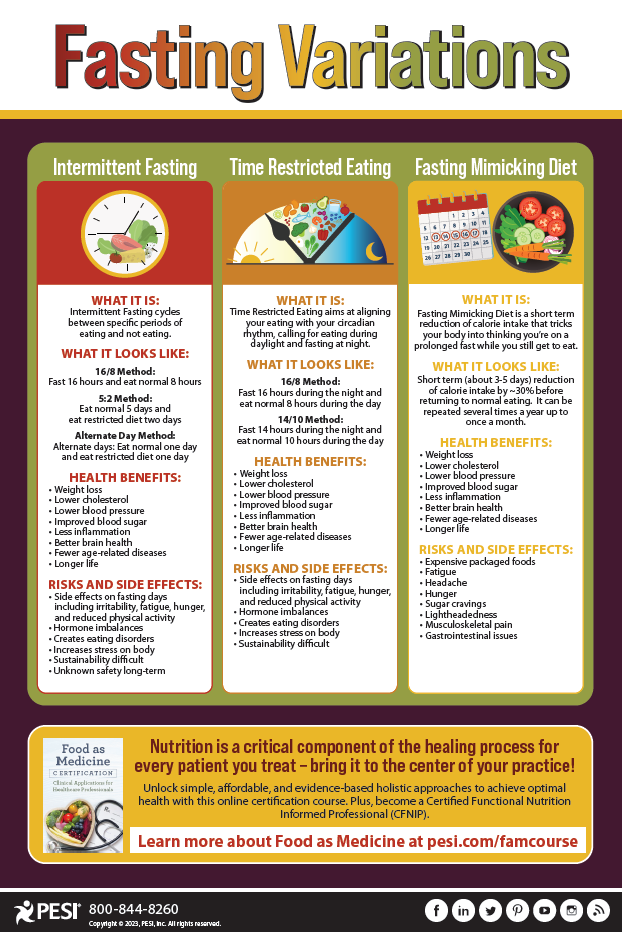Fasting Variations for Every Patient
FREE infographic on fasting variations

Nutrition is a critical component of the healing process for every patient. Numerous chronic diseases can be prevented, managed, and even reversed with proper nutrition. And healthcare professionals play a crucial role in promoting balanced and evidence-based approaches to fasting and nutrition.
Historically, humans naturally fasted, intermittently, due to food availability. Currently, humans have widely available high caloric and processed foods, plus they are more sedentary leading to obesity and disease. Intermittent fasting is a dietary approach that had gained significant attention and popularity in recent years. Its rise in popularity was fueled by various factors, including weight loss benefits, ease of implementation, scientific research, and flexible approach.
But there are other options to fasting besides intermittent fasting. Below, we break down 3 flexible approaches and variations.
There are several different methods of intermittent fasting, but the most common ones include:
16/8 method: This method involves fasting for 16 hours each day and restricting your eating window to 8 hours. For example, you might eat between 12:00 PM and 8:00 PM, and fast from 8:00 PM until 12:00 PM the following day.
5:2 method: In this approach, you eat normally for five days a week and reduce your calorie intake to around 500-600 calories on the remaining two non-consecutive days. These two days are not completely fasting days but are considered very low-calorie days.
Alternate-day fasting: With this method, you alternate between fasting days and regular eating days. On fasting days, you might consume very few calories or none at all, and on regular eating days, you eat normally.
The two most common methods of time restricted eating are:
16/8 method: In this approach, you fast for 16 hours during the night and eat normal for 8 hours during the day.
14/10 method: This method involves fasting for 14 hours during the night and restricting your eating window to 10 hours during the day.
Download this FREE infographic to give you the breakdown of each fasting variation and how they compare to each other including what it is, what it looks like, health benefits and risk and side effects.
Historically, humans naturally fasted, intermittently, due to food availability. Currently, humans have widely available high caloric and processed foods, plus they are more sedentary leading to obesity and disease. Intermittent fasting is a dietary approach that had gained significant attention and popularity in recent years. Its rise in popularity was fueled by various factors, including weight loss benefits, ease of implementation, scientific research, and flexible approach.
But there are other options to fasting besides intermittent fasting. Below, we break down 3 flexible approaches and variations.
Intermittent fasting
Intermittent fasting is a dietary approach that involves cycling between periods of eating and fasting. The concept behind intermittent fasting is not centered around what you eat, but rather when you eat.There are several different methods of intermittent fasting, but the most common ones include:
16/8 method: This method involves fasting for 16 hours each day and restricting your eating window to 8 hours. For example, you might eat between 12:00 PM and 8:00 PM, and fast from 8:00 PM until 12:00 PM the following day.
5:2 method: In this approach, you eat normally for five days a week and reduce your calorie intake to around 500-600 calories on the remaining two non-consecutive days. These two days are not completely fasting days but are considered very low-calorie days.
Alternate-day fasting: With this method, you alternate between fasting days and regular eating days. On fasting days, you might consume very few calories or none at all, and on regular eating days, you eat normally.
Time restricted eating
Time restricted eating aims at aligning your eating with your circadian rhythm, calling for eating during daylight and fasting at night.The two most common methods of time restricted eating are:
16/8 method: In this approach, you fast for 16 hours during the night and eat normal for 8 hours during the day.
14/10 method: This method involves fasting for 14 hours during the night and restricting your eating window to 10 hours during the day.
Fasting mimicking diet
The fasting-mimicking diet (FMD) is a dietary approach designed to simulate the beneficial effects of fasting while still allowing the consumption of some food. The fasting-mimicking diet typically involves following a specific meal plan for a set number of days, usually ranging from five to seven consecutive days. During these days, calorie intake is significantly reduced, providing the body with specific nutrients while keeping it in a fasting-like state.Download this FREE infographic to give you the breakdown of each fasting variation and how they compare to each other including what it is, what it looks like, health benefits and risk and side effects.
Food as Medicine Certification

Nutrition is a critical component of the healing process for every patient you treat. Not only will you learn the most current science and evidence-based tools, but also simple lifestyle hacks that lead to lasting behavior change. This comprehensive training is filled with actionable techniques that you can use immediately!
Meet the Expert:
Cindi Lockhart, RDN, LD, IFNCP, is board-certified as an integrative and functional nutrition practitioner with over 27 years in professional practice. She has trained nutrition, fitness, and medical practitioners throughout most of her career, yet maintains a personal practice with clients/patients as she believes that the only way she can effectively educate and inspire other practitioners is through her own practical experience with clients. In addition to educating on how Food is Medicine, Cindi also specializes in coaching clients and practitioners on the importance of managing stress, optimizing sleep, proper exercise and movement, and reducing exposure to environmental toxins. Cindi has extensive expertise in women’s health issues including hormonal imbalances, infertility, thyroid dysfunction, autoimmunity and gut health.
Learn more about her educational products, including upcoming live seminars, by clicking here.
Learn more about her educational products, including upcoming live seminars, by clicking here.
Topic: Diet and nutrition | Diet and Nutrition
Tags: Diet and nutrition | Nutrition | Nutritional Treatment




